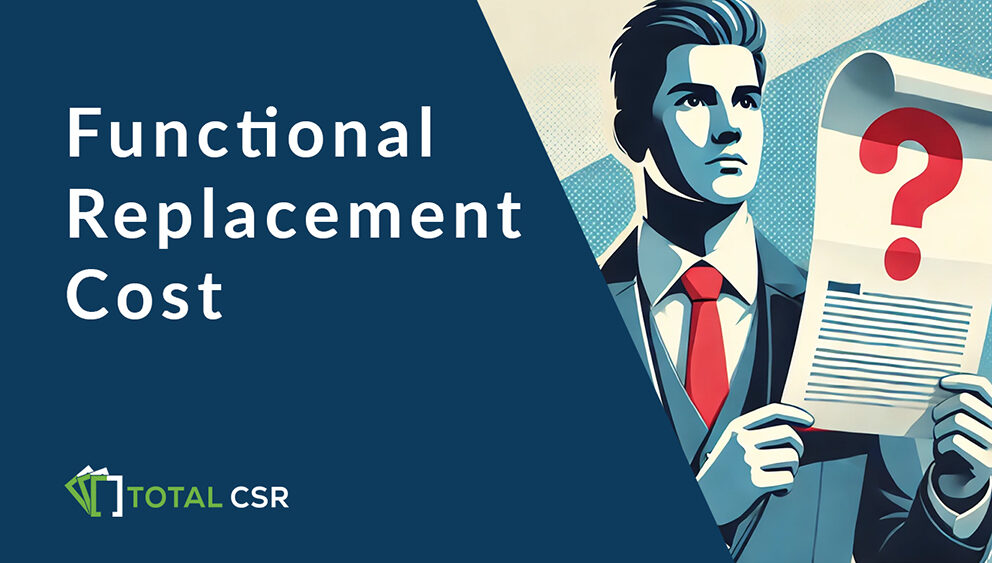Get Started
Follow these simple steps to get started.
- 1
- 2
- 3
Create Account: Step 1 of 3

Functional replacement cost is an important concept in property insurance, offering a balanced way to handle coverage and premiums. This insurance policy choice lies between actual cash value (ACV) and replacement cost value (RCV), making it an appealing option for certain property owners. Grasping the functional replacement cost definition is key to making informed decisions about your insurance coverage and any insurance claims you might file.
Functional replacement cost (FRC)—also called functional replacement value or FRC insurance—is an insurance term used to determine the amount payable for property or item damages covered by a policy. It calculates the cost to repair or replace damaged property with items that perform the same function, even if they differ in appearance, construction materials, or quality.
FRC coverage is particularly beneficial for
To better understand functional replacement cost, compare it with other valuation methods, including actual cash value vs replacement cost:
| Aspect | Functional Replacement Cost (FRC) | Actual Cash Value (ACV) | Replacement Cost Value (RCV) |
|---|---|---|---|
| Valuation Basis | Cost to replace with functionally equivalent items | Replacement cost minus depreciation | Full cost to replace with same/similar items |
| Materials | May use modern, less expensive alternatives | N/A (focuses on current value) | Same or equivalent materials |
| Premium Cost | Lower than RCV, higher than ACV | Lowest | Highest |
| Ideal For | Older structures, budget-conscious property owners | Properties not likely to be rebuilt | New or high-value properties |
FRC finds a sweet spot between coverage and cost, which many property owners appreciate. If you’re weighing functional replacement cost vs replacement cost, keep in mind that RCV (the rcv insurance term or rc insurance meaning) provides full replacement value, whereas FRC concentrates on functional equivalents. Sometimes, a replacement cost endorsement can be added to achieve full coverage of rebuilding costs.
These examples illustrate functional replacement cost loss settlement at work. They also show how the modified functional replacement cost loss settlement method can assist property owners in both total and partial loss scenarios.
FRC might be suitable in these situations:
Functional replacement cost offers a practical route to property insurance, especially if you own older structures or have properties with unique characteristics. FRC policies concentrate on restoring usefulness rather than achieving a precise replication, which helps control premiums. That said, it’s vital to assess your property’s needs thoroughly and consult with an insurance expert to decide whether FRC is the best option in your case.
Some property owners may ask, “Is functional replacement cost bad?” In reality, it depends on individual needs. While FRC may not match the coverage of a full replacement cost insurance policy, it can be a smart choice for those aiming to balance coverage with affordability.
For tailored advice on functional replacement cost coverage, replacement cost endorsements, or for a review of your current homeowners policy or commercial property strategy, reach out to a licensed insurance professional. They can guide you through the complexities of property insurance—covering the replacement cost principle and various valuation methods—so you can protect your valuable assets at a fair market value.
Functional replacement cost (FRC) differs from actual cash value (ACV) by focusing on the cost to replace with similar functionality, often using modern materials, whereas ACV is based on the depreciated value of the property. This means FRC typically offers more coverage than ACV but may not restore original features.
Examples of FRC include replacing plaster walls with drywall or using shingles instead of clay tiles. These substitutions maintain functionality while reducing costs.
FRC is used for older structures where exact materials are costly or unavailable, and when functionality is prioritized over exact replication. It’s also suitable for properties where high-end finishes are not necessary.
Policy holders should consider that FRC may not restore unique features and could affect property market appeal. It often results in lower premiums but may not be suitable for historically significant properties or those with high-end finishes.
Follow these simple steps to get started.
Create Account: Step 1 of 3
Loading...